A) rightward shift of the short-run aggregate supply curve.
B) leftward shift of the short-run aggregate supply curve.
C) rightward movement along a fixed short-run aggregate supply curve.
D) decrease in aggregate demand.
E) leftward movement along a fixed short-run aggregate supply curve.
Correct Answer

verified
Correct Answer
verified
Multiple Choice
The figure below shows the short-run aggregate supply curve of an economy. If the actual price level exceeds the expected price level, then:
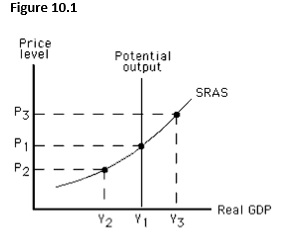
A) equilibrium output is likely to be Y2 in the short run.
B) equilibrium output is likely to be Y1 in the short run.
C) equilibrium output is likely to be Y3 in the short run.
D) potential output is greater than actual output.
E) unemployment is above the natural rate.
Correct Answer

verified
Correct Answer
verified
True/False
Actual output can exceed the economy's potential both in the short run and the long run.
Correct Answer

verified
Correct Answer
verified
Multiple Choice
When the economy produces its potential output, _____ is zero.
A) frictional unemployment
B) cyclical unemployment
C) seasonal unemployment
D) structural unemployment
E) disguised unemployment
Correct Answer

verified
Correct Answer
verified
Multiple Choice
The figure shows the determination of the equilibrium price level and real GDP in an aggregate demand-aggregate supply model. Which of the following economic changes is depicted by a movement from point e to point e'?
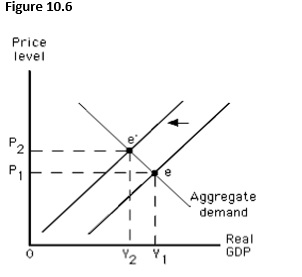
A) An increase in short-run aggregate supply
B) An increase in long-run aggregate supply
C) A decrease in short-run aggregate supply
D) A decrease in long-run aggregate supply
E) An increase in the aggregate quantity demanded
Correct Answer

verified
Correct Answer
verified
Multiple Choice
The figure below shows the short-run aggregate supply curve of an economy. In this figure, an expansionary gap would be represented by the distance between:
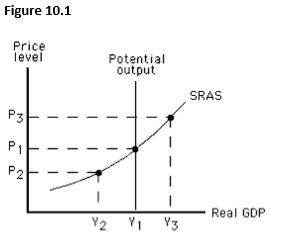
A) Y2and Y1.
B) Y3and Y1.
C) Y2and Y3.
D) P2and P1.
E) P2and P3.
Correct Answer

verified
Correct Answer
verified
Multiple Choice
Which of these is an advantage of long-term contracts in resource markets?
A) Long-term contracts decrease the duration of recessionary gaps.
B) Long-term contracts reduce unemployment below its natural rate.
C) Long-term contracts help avoid recession in an economy.
D) Long-term contracts increase the flexibility of nominal wages.
E) Long-term contracts reduce the average cost of negotiation.
Correct Answer

verified
Correct Answer
verified
Multiple Choice
The figure below shows the determination of the equilibrium price level and real GDP in an aggregate demand-aggregate supply model. The movement shown in this figure is most likely to be caused by:
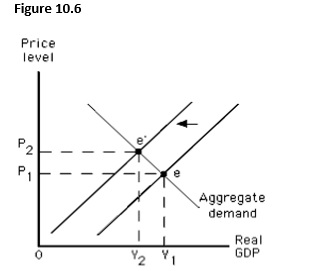
A) a decrease in the real wage.
B) an increase in the economy's capital stock.
C) the actions of a labor union.
D) a decrease in consumer spending.
E) an increase in labor productivity.
Correct Answer

verified
Correct Answer
verified
Multiple Choice
Stagflation is defined as:
A) decreased output accompanied by a higher price level.
B) decreased output accompanied by a lower price level.
C) increased output accompanied by a lower price level.
D) increased output accompanied by a higher price level.
E) stagnation in the rate of inflation.
Correct Answer

verified
Correct Answer
verified
Multiple Choice
In the short run, there is a positive relationship between:
A) inflation and unemployment.
B) inflation and real GDP.
C) the actual price level and the aggregate quantity supplied.
D) the actual price level and unemployment.
E) the actual price level and consumption spending.
Correct Answer

verified
Correct Answer
verified
Multiple Choice
An economy's potential level of output can be altered by changes in:
A) the actual price level.
B) the expected price level.
C) aggregate demand.
D) real GDP.
E) its stock of capital.
Correct Answer

verified
Correct Answer
verified
Multiple Choice
The short-run aggregate supply curve shows a(n) :
A) direct relationship between the expected price level and nominal GDP supplied.
B) inverse relationship between the actual price level and real GDP supplied.
C) direct relationship between the actual price level and nominal GDP supplied.
D) direct relationship between the actual price level and real GDP supplied.
E) inverse relationship between the expected price level and real GDP supplied.
Correct Answer

verified
Correct Answer
verified
Multiple Choice
The short run is a period of time during which:
A) there is an expansionary gap that cannot be corrected using the passive approach.
B) actual output equals potential output.
C) there is a recessionary gap that cannot be corrected through discretionary policy.
D) resource buyers and sellers cannot adjust fully to changes in the price level.
E) resource buyers and sellers can adjust fully to changes in the price level.
Correct Answer

verified
Correct Answer
verified
True/False
Wage rates are typically flexible upward but "sticky" downward.
Correct Answer

verified
Correct Answer
verified
Multiple Choice
Which of the following is true of the short-run aggregate supply curve?
A) It shows the relation between the inflation rate and the quantity of aggregate output firms supply, other things constant.
B) It shows the relation between the price of labor and the aggregate quantity of labor workers supply, other things constant.
C) It shows the relation between the interest rate and the quantity of capital goods firms supply, other things constant.
D) It shows the relation between the price level and the quantity of aggregate output firms supply, other things constant.
E) It shows an inverse relationship between the price level and real GDP.
Correct Answer

verified
Correct Answer
verified
Multiple Choice
In constructing the short-run aggregate supply curve, we define the short run as the period in which:
A) the price level is constant.
B) output is fixed.
C) profit is constant.
D) the costs of some resources are fixed.
E) the economic growth rate is less than 4 percent.
Correct Answer

verified
Correct Answer
verified
Multiple Choice
Given the aggregate demand curve, a beneficial supply shock will:
A) increase potential output and the price level.
B) decrease potential output and the price level.
C) increase potential output and decrease the price level.
D) decrease potential output and increase the price level.
E) cause no change in potential output or the price level.
Correct Answer

verified
Correct Answer
verified
True/False
The short-run equilibrium output in the economy described by the figure given below is Y1.
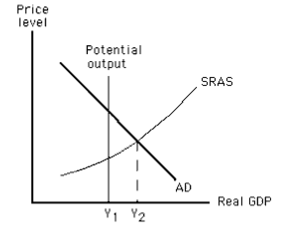
Correct Answer

verified
Correct Answer
verified
Multiple Choice
Which of the following changes best represents the effect of the oil embargo (a shut-off of oil from certain OPEC countries) of the 1970s on the U.S.?
A) A leftward shift of the long-run aggregate supply curve
B) A rightward shift of the long-run aggregate supply curve
C) A leftward shift of the aggregate demand curve
D) A rightward shift of the aggregate demand curve
E) A rightward movement along a given aggregate demand curve
Correct Answer

verified
Correct Answer
verified
Multiple Choice
The main effect of a decrease in the stock of capital is a(n) :
A) rightward shift of the short-run aggregate supply curve.
B) rightward shift of the aggregate demand curve.
C) leftward shift of the long-run aggregate supply curve.
D) leftward shift of the aggregate demand curve.
E) increase in the price and output levels.
Correct Answer

verified
Correct Answer
verified
Showing 41 - 60 of 150
Related Exams